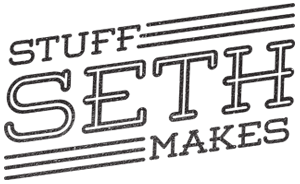When it comes to woodworking there’s always some sort of technique I want to try, or a detail I want to incorporate into a project. With hardwood lumber pricing being what it is these days, I can’t always afford to risk wasting that nice material if the thing I want to try doesn’t work out.
To take less of a financial risk while still being able to try the thing, I tend to use “affordable” plywood to practice with. Sometimes I try it on a small scrap of plywood just to see how it goes, and sometimes i’ll try it on larger pieces of plywood if I need to see more scale. Sometimes it actually turns into a whole piece of furniture for the shop, which is what happened here.
Disclaimer: As an Amazon Associate, I earn from qualifying purchases.
A few years ago I built a single drawer box out of baltic birch plywood to set my Ridgid oscillating sander on:
.jpg)
I built that so I could practice cove cutting on the table saw which was a technique I had just learned at the Jory Brigham workshop in Paso Robles, CA (if you’re getting into furniture making I highly recommend doing a weekend course…over the last few years I’ve done 2 of the ones he offers and have learned SO much). Fast forward to now and I could really use some more storage in the shop, and I wanted to try some narrow flutes using my router table and a large core box router bit. I decided to make a new 5-drawer unit.
After building the cabinet box and edge banding the front edges with scrap walnut, i built my drawer boxes and installed some basic full-extension drawer slides. Not the most elegant or glamorous drawer boxes or drawer slides but they’re fine for shop furniture (if this was a “real” piece of furniture I’d be making the drawer boxes out of hardwood and using soft close undermount drawer slides like I did on this built-in window bench with storage). I cut a piece of plywood to the width I wanted my drawer faces to be, and this measurement included a 1/8-inch gap on the left and right. The height measurement wasn’t critical at this point since I’d eventually be making crosscuts anyway. After doing a little math and making some marks 1-inch apart, I set the router bit to the height I wanted and set my table saw fence where I wanted the first flute to be.
.jpg)
This is a perfect example of why I love having my router table mounted on this wing of the table saw. Using the table saw fence is much easier to make accurate adjustments and I can adjust the table saw fence much further away than if I was using the router table fence.
.gif)
I make my first pass over the router bit…voila! I rotated the plywood 180 degrees and made the same pass on that side…voila! Adjust the fence an inch…next pass….rotate…next pass…adjust…next pass…rotate…next pass…adjust. I think you see where this is going!
Using the plywood, i knew these cuts would expose the multiple layers of the plywood. Since this wasn’t the nice fancy (and expensive) baltic birch plywood, I wasn’t sure of the quality of those middle layers and how that would affect the look of the exposed layers. As it turns out, they looked pretty dang interesting! Making these cuts at the router table exposed colors and textures that i wasn’t expecting but I loved how they looked in the valleys of the flutes!
.jpg)
I also wanted to try making some walnut drawer pulls so I milled some more scrap walnut to a size I liked. On these pulls, i wanted to use a smaller core box router bit on the underside to create a rounded groove that your fingertips catch as you pull the drawer forward. So I calculated where those needed to be and made quick work over at the router table.
.jpg)
.jpg)
After making the finger grooves I shaped the pulls to have a subtle arch, and then rounded over the top edge. After I crosscut the plywood to the heights needed for each drawer face, I glued the new drawer pulls to the top edge of each face. The glue alone would be strong enough to hold the pulls in place but I wanted to try one more thing.
To add a little extra bit of strength I wanted to use brass pins inserted through the top of the pulls that extend down into the drawer face. A regular brass pin would be fine for this but I decided to try using a thin-wall brass TUBE and I thinned down some walnut dowels to fit snugly INSIDE the tube. Then I could drill my pin holes and insert the walnut-filled brass tube, secure it with glue, trim it, flush it up. Boom.
.jpg)
.jpg)
I’m so happy with this piece of shop furniture and it’s always exciting seeing ideas come to life, and mounting the Rockler Dust Right hookup to the side will make it easier to attach my JET dust collector so I don’t have to reach around the back of the tool to connect the hose anymore. Now that the practice piece is out of the way, who’s ready for some walnut custom furniture?? Walnut not your thing? Let’s do white oak!! Maybe you’re more of an ash with black stain kind of person….let’s do it! I’m all about CUSTOM.
.jpg)
.jpg)
If you’re looking for a piece of furniture for your home, I look forward to hearing from you! Send me an inquiry through my contact page and let’s get something in the works. Thanks for looking!







